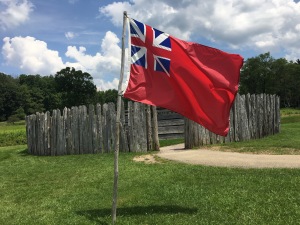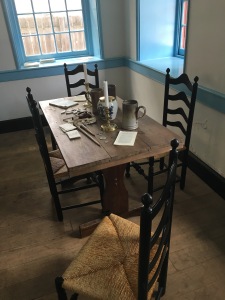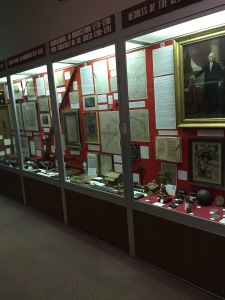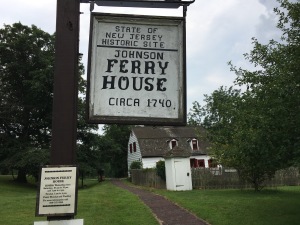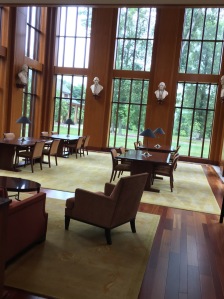
Outer view of Fort Ligonier
Having visited Fort Necessity yesterday, I was almost blown away when I visited Fort Ligonier today (8/2/17). The expanse of the fort absolutely blew me away. But the fort itself is not all that is impressive at Fort Ligonier.
When I first entered the Museum, I was honestly disappointed–the museum covers the 7 Years’ War (The International Conflict which the French Indian War contributed to) starting with the War of Austrian Succession for back story. I have gotten to the place of such a specific focus that I was especially looking for new information on that section. Once I got past the “This wasn’t what I was expecting” feelings, I started to actually look at the exhibits. I was completely blown away by the artifacts they have. They host a case dedicated to each country involved in the 7 Years’ War, complete with uniforms, weapons, and a host of other artifacts. How a museum in Pennsylvania acquired such amazing artifacts from Asia, Africa, and all over Europe and the colonies, I’ll never know, but the collection is one of the finest I’ve seen.

Display area
Additionally, they currently have a rare collection of Washington artifacts (with more exhibits promised to come). The current collection includes his dueling pistols (given to him by the Marquis de Lafayette) and his handwritten remarks (originals) about the French Indian War. It also has a gallery of art about the French Indian War and the original parlor of St. Clair. I’m excited to see all the changes they bring.
Fort Ligonier also offers a variety of activities for kids. Today was cannonball club–children got in Free. And on the first Friday of the month in the summer months, everyone is free (Friendly Fire Fridays). I chose to pay to come today to a.) miss the crowd and b.) not have to hike around in the rain (predicted for Friday). But, this definitely seems to be a place that offers a ton of activities for kids (The lobby has children’s writings and projects about the fort on display!)

Supplies
Outside the museum, the fort is incredibly impressive. This was the last fort along Forbes road as he was preparing to assault Fort Duquesne (and pick up the pieces after Braddock’s miserable defeat.) Still, the amount of buildings was incredible! There were barracks, officers quarters, quarter masters, hospital areas, a cellar for gunpowder complete with a ladder you have to climb down to get in–all designed from two original maps of the fort telling precisely what went where. There’s also an additional officers’ quarters not on the map, but the archaeological evidence indicates both the foundation and the use of the building.

Officers’ quarters
My favorite part of the fort was the officers quarters where Washington stayed with two other officers. In it, there is a sign which tells of an incident I had read described by another soldier in a first hand account. Washington was bringing his men to support some Virginians under attack. Because it was dusk, the troops they were going to reinforce fired on them, and Washington’s men fired back.

Washington’s dueling pistols
Washington rode down the middle of the two groups, pushing guns aside, and yelling at the men not to fire. In the first hand account I heard, it stated that the man was terrified because Washington was right in the middle of the two armies when the volley rang out. But, when the smoke cleared, George was still standing (riding, actually), though he later writes that the encounter had placed his life “in as much jeopardy as it had ever been before or since.” But, that’s not the only time a bullet would miss Washington. (I later learned that after he had delivered Governor Dinwiddie’s letter demanding the French leave and been rejected, as Washington was walking the 450 miles back to Williamsburg, one of his Indian guides who had been turned by the French at Ft. LeBoeuf took a shot at him, narrowly missing him. Washington and Christopher Gist chased him, but he got away.)

Braddock Battlefield History Center–sharing a building with a gymnastics club
I left Fort Ligonier to head to the Braddock Battlefield History Center. I had learned from another website that there were very few reminders of the battle I wanted to cover, but this museum was one. It’s open Tuesdays, Wednesdays, Saturdays, and Sundays from 12-4 or by appointment. Interesting hours, but the man who started it 20 years ago is a wealth of information and worth any drive!

Area surrounding Washington Statue
The area itself made me sad. It reminded me of Gary, back home in Indiana–an area once thriving and cultural because of the steel mills and now boarded up and passed over. I understand why the museum creator Robert T. Messner wanted to build a museum on the forgotten battlefield where so much history took place.
The Museum offers an hour video, which seems like a lot, but is so informative, it’s absolutely worth it. Then, the Mr. Messner sat with me for another hour and explained the entire background of the battle. His Museum also includes over 250 artifacts and 50 paintings or works of art (including ones he doesn’t like for their inaccuracies, but he is committed to displaying the art about the battle–even the bad art.) He also focuses on the role the Native Americans played in this battle, which by casualties inflicted was the second most important Native American battle–The defeat of St. Claire (of my Fort Ligonier visit fame) being number 1 and Custer’s Last Stand being a less noteworthy 10. He pointed out that when the French Commander was shot in one of the early volleys of the battle, it threw the French into a state of confusion but released the Native Americans from any responsibility to leadership, so they were free to fight the battle the way they wanted–with disastrous effect.
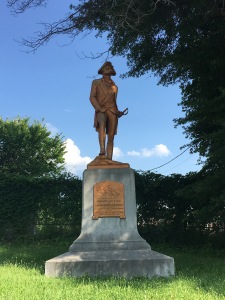
Statue at the site of the Battle of Monongahela
They flanked Braddock’s line and poured into them, specifically targeting officers and drummer boys. Casualties among the army are around 70%, while casualties among the officers are around 90%. That Washington made it out alive is miraculous!
Mr. Messner defends Braddock, however, despite the fact that he disregarded and alienated Native tribes and ignored Washington’s advice that a huge group of red coats was a giant target. Washington had fought Indians before. Braddock had not. But, Messner points out that the British made battle plans expecting the land in America to be the same as it was in Britain. So, when they say, “March from here to here,” they’re not considering that he has to fell trees and actually build a road to go over the Appalachians! Add to that the fact that his troops consist of every other regiment’s cast offs (Seriously, would you send him your best soldiers?), and to get any money for his engagements, he has to go through the Pennsylvania Assembly instead of the crown–an Assembly made up largely of Quakers who don’t believe in fighting in the first place. I see his points.
Additionally, he points out (as will Washington) the cruelty of timing. Most of the Indian tribes were from Wisconsin, Michigan, and Ontario–it took them a while to get there and they weren’t going to stay forever. The fact that Braddock had taken a month to train his men instead of marching straight to Ft. Duquesne means he met the Indians who had arrived two weeks previously. Had he trained longer, the Indians would have left–as they did at Fort Necessity facilitating the parlay. Brutal timing.

Painting of Benjamin Franklin and Braddock
Three other things stood out from my discussion with Mr. Messner. First, he has a painting which shows Benjamin Franklin talking to General Braddock (The original hangs in the library down the street from the Museum.) Apparently, Benjamin Franklin tried to warn Braddock not to fight in lines and that the Native Americans would decimate them. But, Braddock scoffs and says essentially that maybe they could defeat the Colonials, but they held no threat to the British Army. How wrong he was! This understanding that the British had no idea how to fight on American soil planted the seeds that they could possibly be overcome when we decide to take them on ourselves.
The second thing that stood out was he mentioned that Monongahela was Washington’s last major engagement before he is named commander-in-chief 20 years later. That’s when it struck me–he wore his uniform to the Continental Congress 20 Years Later! The uniform he wore as a 20 year old, still fit him as a 40 year old! (Though Messner points out he looks a bit chubby in the painting…) Still, how many people can fit into clothes they wore 20 years ago.
The final point of interest at the museum is another of what I call “Histories Mysteries.” In a box buried shallowly on the battlefield is found rings, coins, and a medal from Russian Empress Anna Ivanovna. The speculation is that the box belonged to a surgeon and the contents were things taken from bodies. But, why a Russian medal from an incredibly unpopular Russian leader? Definitely a mystery!
All in all, it was a fascinating day and two places I definitely recommend!














